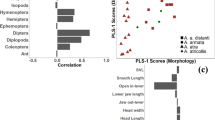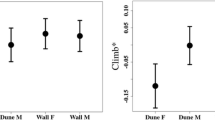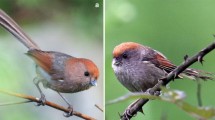Abstract
Understanding the relationship between form and function is central to our comprehension of how phenotypic diversity evolves. Traits involved in multiple activities, such as social interactions and ecological resource use, are under the influence of different evolutionary forces potentially acting in opposite directions. Such systems provide the opportunity of understanding how potential constraints on morphological variation may influence whole-organism performance. In this study we examined morphology and bite performance in two closely related species of Podarcis wall lizards with divergent microhabitat preferences, to investigate how natural and sexual selection interact to shape the evolution of head traits. Our results show that although head morphology is markedly different between species and sexes, only sexes differ in bite force, indicating that the ecological differentiation between species is reflected in their morphology but does not constrain performance. Rather, the modification of the relative size of head components between species and a shift in the form-function relationship provide a potential explanation of how equal performance is attained by different morphological configurations. Geometric morphometrics provide a clear, biomechanically meaningful image of how this is achieved and show a bisexual pattern of head shape-bite force association in both species. This, together with a strong allometry of head size on body size and head shape on head size, provides indirect morphological evidence for the importance of sexual selection in shaping morphological and functional patterns. Finally, our findings suggest that the differences observed between species and sexes in head traits and bite performance are not reflected in their dietary ecology, implying that if trophic niche segregation between groups occurs, the reasons behind it are not primarily related to head morphology and functional variation.






Similar content being viewed by others
References
Adams DC (2004) Character displacement via aggressive interference in Appalachian salamanders. Ecology 85:2664–2670
Adams DC, Nistri A (2010) Ontogenetic convergence and evolution of foot morphology in European cave salamanders (Family: Plethodontidae). BMC Evol Biol 10(216):1–10
Adams DC, Rohlf FJ (2000) Ecological character displacement in Plethodon: biomechanical differences found from a geometric morphometric study. Proc Nat Acad Sci USA 97:4106–4111
Adams DC, Rohlf FJ, Slice DE (2004) Geometric morphometrics: ten years of progress following the ‘revolution’. Ital J Zool 71:5–16
Alfaro ME, Bolnick DI, Wainwright PC (2004) Evolutionary dynamics of complex biomechanical systems: an example using the four-bar mechanism. Evolution 58:495–503
Alfaro ME, Bolnick DI, Wainwright PC (2005) Evolutionary consequences of many-to-one mapping of jaw morphology to mechanics in labrid fishes. Am Nat 165:E140–E154
Andersson M (1994) Sexual selection: monographs in behavior and ecology. Princeton University Press, Princeton
Arnold EN (1973) Relationships of the Palearctic lizards assigned to the genera Lacerta, Algyroides and Psammodromus (Reptilia: Lacertidae). Bull Br Mus 25:289–366
Arnold SJ (1983) Morphology, performance and fitness. Am Zool 23:347–361
Arnold EN (1987) Resource partition among lacertid lizards in southern Europe. J Zool Lond (B) 1:739–782
Arnold EN (1998) Cranial kinesis in lizards: variations, uses and origins. Evol Biol 30:323–357
Bonduriansky R (2007) Sexual selection and allometry: a critical reappraisal of the evidence and ideas. Evolution 61:838–849
Bonduriansky R, Day T (2003) The evolution of static allometry in sexually selected traits. Evolution 57:2450–2458
Bookstein FL (1991) Morphometric tools for landmark data: geometry and biology. Cambridge University Press, Cambridge
Braña F (1996) Sexual dimorphism in lacertid lizards: male head increase vs female abdomen increase? Oikos 75:511–523
Brecko J, Huyghe K, Vanhooydonck B, Herrel A, Grbac I (2008) Functional and ecological relevance of intraspecific variation in body size and shape in the lizard Podarcis melisellensis (Lacertidae). Biol J Linn Soc 94:251–264
Bruner E, Constantini D (2007) Head morphological variation in Podarcis muralis and Podarcis sicula: a landmark-based approach. Amphib Reptilia 28:566–573
Burnham KP, Anderson DR (2002) Model selection and multi-model inference: a practical-theoretic approach, 2nd edn. Springer, New York
Butler MA, Losos JB (2002) Multivariate sexual dimorphism, sexual selection, and adaptation in Greater Antillean Anolis lizards. Ecol Monogr 72:541–559
Butler MA, Sawyer SA, Losos JB (2007) Sexual dimorphism and adaptive radiation in Anolis lizards. Nature 447:202–205
Carretero MA (2004) Form set menu to a la carte. Linking issues in trophic ecology of Mediterranean lizards. Ital J Zool Supp 2:121–133
Carretero MA (2008) An integrated assessment of the specific status in a group with complex systematics: the Iberomaghrebian lizard genus Podarcis (Squamata, Lacertidae). Integr Zool 4:247–266
Carretero MA, Llorente GA (2001) What are they really eating? Stomach versus intestine as sources of diet information in lacertids. In: Vicente L, Crespo EG (eds) Mediterranean basin lacertid lizards: a biological approach. ICN, Lisbon, pp 105–112
Cooper WE Jr., Vitt LJ (1989) Sexual dimorphism of head and body size in an iguanid lizard: paradoxical results. Am Nat 133:729–735
Diaz JA (1995) Prey selection by lacertid lizards: a short review. Herp J 5:245–251
Drake AG, Klingenberg CP (2008) The pace of morphological change: historical transformation of skull shape in St Bernard dogs. Proc R Soc B 275:71–76
Harris DJ, Sá-Sousa P (2002) Molecular phylogenetics of Iberian Wall Lizards (Podarcis): is Podarcis hispanica a species complex? Mol Phylogenet Evol 23:75–81
Herrel A, O’Reilly JC (2006) Ontogenetic scaling of bite force in lizards and turtles. Phys Biochem Zool 79:31–42
Herrel A, Van Damme R, de Vree F (1996) Sexual dimorphism of head size in Podarcis hispanica atrata: testing the dietary divergence hypothesis by bite force analysis. Neth J Zool 46:253–262
Herrel A, Aerts P, De Vree F (1998a) Ecomorphology of the lizard feeding apparatus: a modelling approach. Neth J Zool 48:1–25
Herrel A, Aerts P, De Vree F (1998b) Static biting in lizards: functional morphology of the temporal ligaments. J Zool Lond 244:135–143
Herrel A, de Grauw E, Lemos-Espinal JA (2001a) Head shape and bite performance in xenosaurid lizards. J Exp Zool 290:101–107
Herrel A, Meyers JJ, Vanhooydonck B (2001b) Correlations between habitat use and body shape in a phrynosomatid lizard (Urosaurus ornatus): a population-level analysis. Biol J Linn Soc 74:305–314
Herrel A, Meyers J, Nishikawa KC, De Vree F (2001c) The evolution of feeding motor patterns in lizards: modulatory complexity and possible constraints. Am Zool 41:1311–1320
Herrel A, Van Damme R, Vanhooydonck B, De Vree F (2001d) The implications of bite performance for diet in two species of lacertid lizards. Can J Zool 79:662–670
Herrel A, McBrayer LD, Larson PM (2010) Functional basis for sexual differences in bite force in the lizard Anolis carolinensis. Biol J Linn Soc 91:111–119
Husak JF, Fox SF (2008) Sexual selection on locomotor performance. Evol Ecol Res 10:213–228
Husak JF, Lappin AK, Fox SF, Lemos-Espinal JA (2006a) Bite-force performance predicts dominance in male venerable collared lizards (Crotaphytus antiquus). Copeia 2006:301–306
Husak JF, Fox SF, Lovern MB, van den Bussche RA (2006b) Faster lizards sire more offspring: sexual selection on whole-animal performance. Evolution 60:2122–2130
Husak JF, Lappin AK, van den Bussche RA (2009) The fitness advantage of a high-performance weapon. Biol J Linn Soc 96:840–845
Huyghe K, Vanhooydonck B, Scheers H, Molina-Borja M, Van Damme R (2005) Morphology, performance and fighting capacity in male lizards, Gallotia galloti. Funct Ecol 19:800–807
Huyghe K, Herrel A, Adriaens D, Tadić Z, Van Damme R (2009) It is all in the head: morphological basis for differences in bite force among colour morphs of the Dalmatian wall lizard. Biol J Linn Soc 96:13–22
Irschick DJ, Herrel A, Vanhooydonck B, Van Damme R (2007) A functional approach to sexual selection. Funct Ecol 21:621–626
Irschick DJ, Meyers JJ, Husak JF, Le Galliard JF (2008) How does selection operate on whole-organism functional performance capacities? A review and synthesis. Evol Ecol Res 10:177–196
Kaliontzopoulou A, Carretero MA, Llorente GA (2006) Patterns of shape and size sexual dimorphism in a population of Podarcis hispanica* (Reptilia: Lacertidae) from NE Iberia. In: Corti C, Lo Cascio P, Biaggini M (eds) Mainland and insular lacertid lizards: a mediterranean perspective. Firenze University Press, Firenze, pp 73–89
Kaliontzopoulou A, Carretero MA, Llorente GA (2007) Multivariate and geometric morphometrics in the analysis of sexual dimorphism variation in Podarcis lizards. J Morphol 268:152–165
Kaliontzopoulou A, Carretero MA, Llorente GA (2008) Head shape allometry and proximate causes of head sexual dimorphism in Podarcis lizards: joining linear and geometric morphometrics. Biol J Linn Soc 93:111–124
Kaliontzopoulou A, Carretero MA, Llorente GA (2010) Intraspecific ecomorphological variation: linear and geometric morphometrics reveal habitat-related patterns within Podarcis bocagei wall lizards. J Evol Biol 23:1234–1244
Kaliontzopoulou A, Pinho C, Harris DJ, Carretero MA (2011) When cryptic diversity blurs the picture: a cautionary tale from Iberian and North African Podarcis wall lizards. Biol J Linn Soc 103:779–800
Kingsolver J, Huey RB (2003) Introduction: the evolution of morphology, performance, and fitness. Integr Comp Biol 43:361–366
Kratochvíl L, Frynta D (2002) Body size, male combat and the evolution of sexual dimorphism in eublepharid geckos (Squamata: Eublepharidae). Biol J Linn Soc 76:303–314
Kratochvíl L, Fokt M, Rehák I, Frynta D (2003) Misinterpretation of character scaling: a tale of sexual dimorphism in body shape of common lizards. Can J Zool 81:1112–1117
Lailvaux SP, Irschick DJ (2006) A functional perspective on sexual selection: insights and future prospects. Anim Behav 72:263–273
Lailvaux SP, Irschick DJ (2007) The evolution of performance-based male fighting ability in Caribbean Anolis lizards. Am Nat 170:573–586
Lappin AK, Husak JF (2005) Weapon performance, not size, determines mating success and potential reproductive output in the collared lizard (Crotaphytus collaris). Am Nat 166:426–436
Lappin AK, Hamilton PS, Sullivan BK (2006) Bite-performance and head shape in a sexually dimorphic crevice-dwelling lizard, the common chuckwalla [Sauromalus ater (=obesus)]. Biol J Linn Soc 88:215–222
Legendre P, Legendre L (1998) Numerical ecology, 2nd English edn. Elsevier, Amsterdam
Ljubisavljević K, Urosević A, Aleksić I, Ivanović A (2010) Sexual dimorphism of skull shape in a lacertid lizard species (Podarcis spp., Dalmatolacerta sp., Dinarolacerta sp.) revealed by geometric morphometrics. Zoology 113:168–174
Losos JB, Butler MA, Schoener TW (2003) Sexual dimorphism in body size and shape in relation to habitat use among species of Caribbean Anolis lizards. In: Fox SF, McCoy JK, Baird TA (eds) Lizard social behaviour. John Hopkins University Press, Baltimore, pp 356–380
Maerz JC, Myers EM, Adams DC (2006) Trophic polymorphism in a terrestrial salamander. Evol Ecol Res 8:23–35
McBrayer LD (2004) The relationship between skull morphology, biting performance and foraging mode in Kalahari lacertid lizards. Zool J Linn Soc 140:403–416
Measey GJ, Hopkins K, Tolley KA (2009) Morphology, ornaments and performance in two chameleon ecomorphs: is the casque bigger than the bite? Zoology 112:217–226
Metzger KA, Herrel A (2005) Correlations between lizard cranial shape and diet: a quantitative, phylogenetically informed analysis. Biol J Linn Soc 86:433–466
Mosimann JE (1970) Size allometry: size and shape variables with characterizations of the lognormal and generalized gamma distributions. J Am Stat Assoc 65:930–945
Perrin N, Travis J (1992) On the use of constraints in evolutionary biology and some allergic reactions to them. Funct Ecol 6:361–363
Perry G, Pianka ER (1997) Animal foraging: past, present and future. Trends Ecol Evol 12:360–364
Pianka ER (1973) The structure of lizard communities. Annu Rev Ecol Syst 4:53–74
Pinho C, Ferrand N, Harris DJ (2006) Reexamination of the Iberian and North African Podarcis (Squamata: Lacertidae) phylogeny based on increased mitochondrial DNA sequencing. Mol Phylogenet Evol 38:266–273
Piras P, Salvi D, Ferrara G, Maiorino L, Delfino M, Pedde L, Kotsakis T (2011) The role of postnatal ontogeny in the evolution of phenotypic diversity in Podarcis lizards. J Evol Biol (in press)
Preest MR (1994) Sexual size dimorphism and feeding energetics in Anolis carolinensis: why do females take smaller prey than males? J Herpetol 28:292–298
Raia P, Guarino FM, Turano M, Polese G, Rippa D, Carotenuto F, Monti DM, Cardi M, Fulgione D (2010) The blue lizard spandrel and the island syndrome. BMC Evol Biol 10:289
Rivera G (2008) Ecomorphological variation in shell shape of the freshwater turtle Pseudemys concinna inhabiting different aquatic flow regimes. Integr Comp Biol 48:769–787
Rohlf FJ (2005) tpsDig, digitize landmarks and outlines, version 2.04. Department of Ecology and Evolution, State University of New York at Stony Brook, Stony Brook
Rohlf FJ (2008) tpsRelw, relative warps analysis, version 1.46. Department of Ecology and Evolution, State University of New York at Stony Brook, Stony Brook
Rohlf FJ (2009) tpsRegr, version 1.37. Department of Ecology and Evolution, State University of New York at Stony Brook, Stony Brook
Rohlf FJ, Marcus LF (1993) A revolution in morphometrics. Trends Ecol Evol 8:129–132
Rohlf FJ, Slice DE (1990) Extensions of the Procrustes method for the optimal superimposition of landmarks. Syst Zool 39:40–59
Sá-Sousa P (2001) A controversa sistemática das lagartixas do género Podarcis Wagler, 1830 (Sauria, Lacertidae) em Portugal. PhD thesis, University of Lisbon, Lisbon
Sá-Sousa P, Vicente L, Crespo EG (2002) Morphological variability of Podarcis hispanica (Sauria: Lacertidae) in Portugal. Amphib Reptilia 23:55–69
Schwenk K (2000) Feeding in lepidosaurs. In: Schwenk K (ed) Feeding: form, function and evolution in tetrapod vertebrates. Academic Press, San Diego, pp 175–291
Slice DE (1999) Morpheus et al.: software for morphometric research. Department of Ecology and Evolution, State University of New York, Stony Brook
Slice DE (2005) Modern morphometrics. In: Slice DE (ed) Modern morphometrics in physical anthropology. Kluwer, New York, pp 1–46
Stamps J (1983) Sexual selection, sexual dimorphism and territoriality. In: Huey RB, Pianka ER, Schoener TW (eds) Lizard ecology: studies of a model organism. Harvard University Press, Cambridge, pp 169–204
Stuart-Fox D, Moussalli A (2007) Sex-specific ecomorphological variation and the evolution of sexual dimorphism in dwarf chameleons (Bradypodion spp.). J Evol Biol 20:1073–1081
R Development Core Team (2010) R: A language and environment for statistical computing. R Foundation for Statistical Computing, Vienna. http://www.R-project.org
Toro E, Herrel A, Irschich D (2004) The evolution of jumping performance in Caribbean Anolis lizards: solutions to biomechanical trade-offs. Am Nat 163:844–856
Vanhooydonck B, Van Damme R (1999) Evolutionary relationships between body shape and habitat use in lacertid lizards. Evol Ecol Res 1:785–805
Verwaijen D, Van Damme R, Herrel A (2002) Relationships between head size, bite force, prey handling efficiency and diet in two sympatric lacertid species. Funct Ecol 16:842–850
Vincent SE, Herrel A (2007) Functional and ecological correlates of ecologically-based dimorphisms in squamate reptiles. Integr Comp Biol 47:172–188
Vitt LJ, Caldwell JP, Zani PA, Titus TA (1997) The role of habitat shift in the evolution of lizard morphology: evidence from tropical Tropidurus. Proc Nat Acad Sci USA 94:3828–3832
Wainwright PC (2007) Functional versus morphological diversity in macroevolution. Annu Rev Ecol Evol Syst 38:381–401
Walker JA (2007) A general model of functional constraints on phenotypic evolution. Am Nat 170:681–689
Young MT, Brusatte SL, Ruta M, De Andrade MB (2010) The evolution of Metriorhynchoidea (Mesoeucrocodylia, Thalattosuchia): an integrated approach using geometric morphometrics, analysis of disparity, and biomechanics. Zool J Linn Soc 158:801–859
Acknowledgments
We thank Catarina Rato and Fatima Jorge for help during fieldwork and experimental treatments. Anthony Herrel kindly provided the force transducer used for bite-force measurements. Two anonymous reviewers provided insightful comments that aided in improving a previous version of the manuscript. AK, AvdM and AP were supported by post-doctoral grants (SFRH/BPD/68493/2010, SFRH/BPD/48042/2008 and SFRH/BPD/26546/2006 respectively), all from Fundação para a Ciência e Tecnologia (FCT, Portugal), and DCA was supported in part by NSF grant DEB-0446758. Capture and handling of the animals used were performed under a scientific permit provided by Instituto para a Conservação da Natureza e Biodiversidade (ICNB, Portugal).
Author information
Authors and Affiliations
Corresponding author
Rights and permissions
About this article
Cite this article
Kaliontzopoulou, A., Adams, D.C., van der Meijden, A. et al. Relationships between head morphology, bite performance and ecology in two species of Podarcis wall lizards. Evol Ecol 26, 825–845 (2012). https://doi.org/10.1007/s10682-011-9538-y
Received:
Accepted:
Published:
Issue Date:
DOI: https://doi.org/10.1007/s10682-011-9538-y




